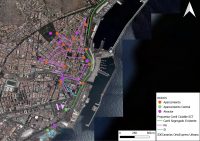
Nothing strikes fear in commuters more than the thought of spending the morning commute stuck in a traffic jam. Spare a thought then for the commuters of Sant Cruz de Tenerife, one of the Canary Islands’ two capitals.
Though the city and hinterland has an extensive bus and tram network, many on the island still choose to commute to work by car. In 2011, 56% of commuters did so, and the problem has only grown in the past decade.
Last year while lockdowns in Spain caused most people to stay home the city still ranked as the third-most congested city in Spain.
‘’It’s not a big city, but we are on an island,’’ said Oliver Lucas Lorenzo from Tenerife City Council. ‘’It’s a traffic challenge that we are facing daily. It makes people think about all the ways that we have to alleviate that, and I think that people are willing to change.’’
Faced with this growing problem, the local government of the Canary Islands has drawn up a new Sustainable Urban Mobility plan to reduce time, costs and emissions for locals.
Santa Cruz is attempting to improve its air quality by becoming more of a ‘smart city’- that is, using digital technology to make traditional networks and services more efficient.
In Santa Cruz, the authority is buying 11 fully electric busses alongside a proportion of other new hybrid ones. While these are funded by the local government, the city has also had a boom in e-scooter companies setting up in the city.
The city is also setting up a new series of air quality monitors in the city. However, this is not just to keep car emissions in check.
‘’The air quality here is quite good,’’ Javier Ferrod, also from Tenerife City Council. He says that the strong western winds across the archipelago reduce any buildup of fumes from cars. This both a blessing and a curse, as the islands are also prone to what locals call a calima; thick layers of dust blown from the Sahara which cause smog-like conditions.
‘’When there’s a storm over there, we feel it here as a heatwave,’’ explains Javier. ‘’When there is a calima, the pollution rates rise very strongly.’’
‘’This will be of help to know how much pollution there is in the city and to inform citizens of measures taken by the city when the pollution is too high,’’ says Javier.
Javier says that the often see what successes other European cities are having. Santa Cruz is a ‘follower city’ in the IRIS project, which brings cities together to show what smart city solutions work across the continent. This collaboration Javier explains proved vital to bring new transport ideas to the city.
Learning about what smart city solutions were being used in mainland European meant that authorities in Santa Cruz could adopt them knowing that they had a high chance of being successful. ‘’Thanks to IRIS, we have turned our point of view as a city and we have gained quite a lot of confidence in electrical buses,’’ says Javier. ‘’Now we’re in love with them!’’
The city is now planning pick up more ideas from other cities and launch further investments when the project ends in 2023.
‘’Before the end of the project, we will probably be seeing many other good things happen in the city,’’ said Javier.

